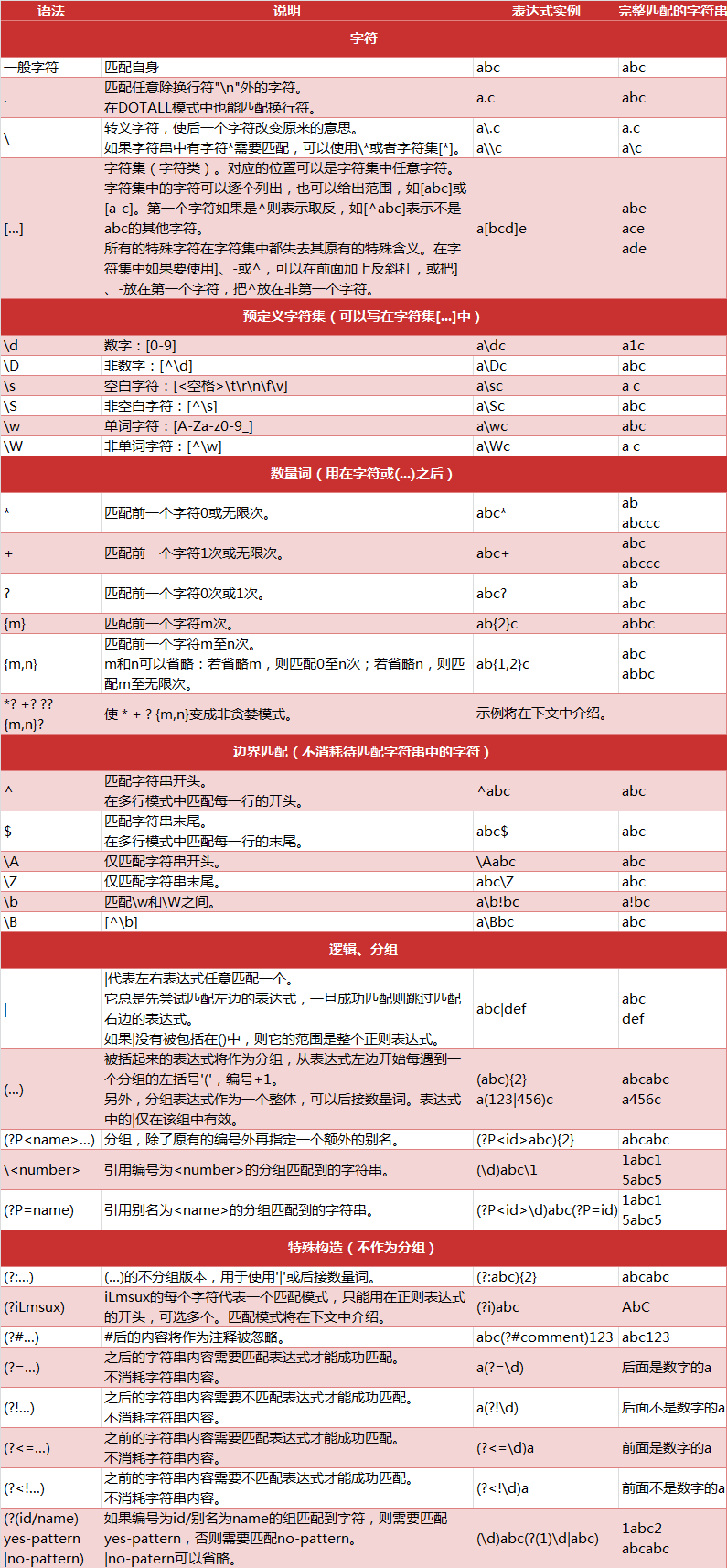python 正则表达式
1.了解正则表达式
/
正则表达式是对字符串操作的一种逻辑公式,就是用事先定义好的一些特定字符、及这些特定字符的组合,组成一个“规则字符串”,这个“规则字符串”用来表达对字符串的一种过滤逻辑。
正则表达式是用来匹配字符串非常强大的工具,在其他编程语言中同样有正则表达式的概念,Python同样不例外,利用了正则表达式,我们想要从返回的页面内容提取出我们想要的内容就易如反掌了。
/
正则表达式的大致匹配过程是:
1.依次拿出表达式和文本中的字符比较,
2.如果每一个字符都能匹配,则匹配成功;一旦有匹配不成功的字符则匹配失败。
3.如果表达式中有量词或边界,这个过程会稍微有一些不同。
2.正则表达式的语法规则
下面是Python中正则表达式的一些匹配规则,图片资料来自CSDN

3.正则表达式相关注解
(1)数量词的贪婪模式与非贪婪模式
正则表达式通常用于在文本中查找匹配的字符串。Python里数量词默认是贪婪的(在少数语言里也可能是默认非贪婪),总是尝试匹配尽可能多的字 符;非贪婪的则相反,总是尝试匹配尽可能少的字符。例如:正则表达式”ab*”如果用于查找”abbbc”,将找到”abbb”。而如果使用非贪婪的数量 词”ab*?”,将找到”a”。
注:我们一般使用非贪婪模式来提取。
(2)反斜杠问题
与大多数编程语言相 同,正则表达式里使用””作为转义字符,这就可能造成反斜杠困扰。假如你需要匹配文本中的字符””,那么使用编程语言表示的正则表达式里将需要4个反 斜杠”\\”:前两个和后两个分别用于在编程语言里转义成反斜杠,转换成两个反斜杠后再在正则表达式里转义成一个反斜杠。
Python里的原生字符串很好地解决了这个问题,这个例子中的正则表达式可以使用r”\”表示。同样,匹配一个数字的”\d”可以写成r”d”。有了原生字符串,妈妈也不用担心是不是漏写了反斜杠,写出来的表达式也更直观勒。
4.Python Re模块
Python 自带了re模块,它提供了对正则表达式的支持。主要用到的方法列举如下
Python| 1 2 3 4 5 6 7 8 9 10 | #返回pattern对象 re.compile(string[,flag]) #以下为匹配所用函数 re.match(pattern, string[, flags]) re.search(pattern, string[, flags]) re.split(pattern, string[, maxsplit]) re.findall(pattern, string[, flags]) re.finditer(pattern, string[, flags]) re.sub(pattern, repl, string[, count]) re.subn(pattern, repl, string[, count]) |
在介绍这几个方法之前,我们先来介绍一下pattern的概念,pattern可以理解为一个匹配模式,那么我们怎么获得这个匹配模式呢?很简单,我们需要利用re.compile方法就可以。例如
Python| 1 | pattern = re.compile(r'hello') |
在参数中我们传入了原生字符串对象,通过compile方法编译生成一个pattern对象,然后我们利用这个对象来进行进一步的匹配。
另外大家可能注意到了另一个参数 flags,在这里解释一下这个参数的含义:
参数flag是匹配模式,取值可以使用按位或运算符’|’表示同时生效,比如re.I | re.M。
可选值有:
Python| 1 2 3 4 5 6 | • re.I(全拼:IGNORECASE): 忽略大小写(括号内是完整写法,下同) • re.M(全拼:MULTILINE): 多行模式,改变'^'和'$'的行为(参见上图) • re.S(全拼:DOTALL): 点任意匹配模式,改变'.'的行为 • re.L(全拼:LOCALE): 使预定字符类 w W b B s S 取决于当前区域设定 • re.U(全拼:UNICODE): 使预定字符类 w W b B s S d D 取决于unicode定义的字符属性 • re.X(全拼:VERBOSE): 详细模式。这个模式下正则表达式可以是多行,忽略空白字符,并可以加入注释。 |
在刚才所说的另外几个方法例如 re.match 里我们就需要用到这个pattern了,下面我们一一介绍。
/
注:以下七个方法中的flags同样是代表匹配模式的意思,如果在pattern生成时已经指明了flags,那么在下面的方法中就不需要传入这个参数了。
(1)re.match(pattern, string[, flags])
这个方法将会从string(我们要匹配的字符串)的开头开始,尝试匹配pattern,一直向后匹配,如果遇到无法匹配的字符,立即返回 None,如果匹配未结束已经到达string的末尾,也会返回None。两个结果均表示匹配失败,否则匹配pattern成功,同时匹配终止,不再对 string向后匹配。下面我们通过一个例子理解一下
Python| 1 2 3 4 5 6 7 8 9 10 11 12 13 14 15 16 17 18 19 20 21 22 23 24 25 26 27 28 29 30 31 32 33 34 35 36 37 38 39 40 41 42 | __author__ = 'CQC' # -*- coding: utf-8 -*- #导入re模块 import re # 将正则表达式编译成Pattern对象,注意hello前面的r的意思是“原生字符串” pattern = re.compile(r'hello') # 使用re.match匹配文本,获得匹配结果,无法匹配时将返回None result1 = re.match(pattern,'hello') result2 = re.match(pattern,'helloo CQC!') result3 = re.match(pattern,'helo CQC!') result4 = re.match(pattern,'hello CQC!') #如果1匹配成功 if result1: # 使用Match获得分组信息 print result1.group() else: print '1匹配失败!' #如果2匹配成功 if result2: # 使用Match获得分组信息 print result2.group() else: print '2匹配失败!' #如果3匹配成功 if result3: # 使用Match获得分组信息 print result3.group() else: print '3匹配失败!' #如果4匹配成功 if result4: # 使用Match获得分组信息 print result4.group() else: print '4匹配失败!' |
运行结果
Python| 1 2 3 4 | hello hello 3匹配失败! hello |
匹配分析
1.第一个匹配,pattern正则表达式为’hello’,我们匹配的目标字符串string也为hello,从头至尾完全匹配,匹配成功。
2.第二个匹配,string为helloo CQC,从string头开始匹配pattern完全可以匹配,pattern匹配结束,同时匹配终止,后面的o CQC不再匹配,返回匹配成功的信息。
3.第三个匹配,string为helo CQC,从string头开始匹配pattern,发现到 ‘o’ 时无法完成匹配,匹配终止,返回None
4.第四个匹配,同第二个匹配原理,即使遇到了空格符也不会受影响。
我们还看到最后打印出了result.group(),这个是什么意思呢?下面我们说一下关于match对象的的属性和方法
Match对象是一次匹配的结果,包含了很多关于此次匹配的信息,可以使用Match提供的可读属性或方法来获取这些信息。
/
属性:
1.string: 匹配时使用的文本。
2.re: 匹配时使用的Pattern对象。
3.pos: 文本中正则表达式开始搜索的索引。值与Pattern.match()和Pattern.seach()方法的同名参数相同。
4.endpos: 文本中正则表达式结束搜索的索引。值与Pattern.match()和Pattern.seach()方法的同名参数相同。
5.lastindex: 最后一个被捕获的分组在文本中的索引。如果没有被捕获的分组,将为None。
6.lastgroup: 最后一个被捕获的分组的别名。如果这个分组没有别名或者没有被捕获的分组,将为None。
方法:
1.group([group1, …]):
获得一个或多个分组截获的字符串;指定多个参数时将以元组形式返回。group1可以使用编号也可以使用别名;编号0代表整个匹配的子串;不填写参数时,返回group(0);没有截获字符串的组返回None;截获了多次的组返回最后一次截获的子串。
2.groups([default]):
以元组形式返回全部分组截获的字符串。相当于调用group(1,2,…last)。default表示没有截获字符串的组以这个值替代,默认为None。
3.groupdict([default]):
返回以有别名的组的别名为键、以该组截获的子串为值的字典,没有别名的组不包含在内。default含义同上。
4.start([group]):
返回指定的组截获的子串在string中的起始索引(子串第一个字符的索引)。group默认值为0。
5.end([group]):
返回指定的组截获的子串在string中的结束索引(子串最后一个字符的索引+1)。group默认值为0。
6.span([group]):
返回(start(group), end(group))。
7.expand(template):
将匹配到的分组代入template中然后返回。template中可以使用id或g、g引用分组,但不能使用编号0。id与g是等价的;但10将被认为是第10个分组,如果你想表达1之后是字符’0’,只能使用g0。
下面我们用一个例子来体会一下
Python| 1 2 3 4 5 6 7 8 9 10 11 12 13 14 15 16 17 18 19 20 21 22 23 24 25 26 27 28 29 30 31 32 33 34 35 36 | # -*- coding: utf-8 -*- #一个简单的match实例 import re # 匹配如下内容:单词+空格+单词+任意字符 m = re.match(r'(w+) (w+)(?P.*)', 'hello world!') print "m.string:", m.string print "m.re:", m.re print "m.pos:", m.pos print "m.endpos:", m.endpos print "m.lastindex:", m.lastindex print "m.lastgroup:", m.lastgroup print "m.group():", m.group() print "m.group(1,2):", m.group(1, 2) print "m.groups():", m.groups() print "m.groupdict():", m.groupdict() print "m.start(2):", m.start(2) print "m.end(2):", m.end(2) print "m.span(2):", m.span(2) print r"m.expand(r'g gg'):", m.expand(r'2 13') ### output ### # m.string: hello world! # m.re: # m.pos: 0 # m.endpos: 12 # m.lastindex: 3 # m.lastgroup: sign # m.group(1,2): ('hello', 'world') # m.groups(): ('hello', 'world', '!') # m.groupdict(): {'sign': '!'} # m.start(2): 6 # m.end(2): 11 # m.span(2): (6, 11) # m.expand(r'2 13'): world hello! |
(2)re.search(pattern, string[, flags])
search方法与match方法极其类似,区别在于match()函数只检测re是不是在string的开始位置匹配,search()会扫描整个string查找匹配,match()只有在0位置匹配成功的话才有返回,如果不是开始位置匹配成功的话,match()就返回None。同样,search方法的返回对象同样match()返回对象的方法和属性。我们用一个例子感受一下
Python| 1 2 3 4 5 6 7 8 9 10 11 12 13 | #导入re模块 import re # 将正则表达式编译成Pattern对象 pattern = re.compile(r'world') # 使用search()查找匹配的子串,不存在能匹配的子串时将返回None # 这个例子中使用match()无法成功匹配 match = re.search(pattern,'hello world!') if match: # 使用Match获得分组信息 print match.group() ### 输出 ### # world |
(3)re.split(pattern, string[, maxsplit])
按照能够匹配的子串将string分割后返回列表。maxsplit用于指定最大分割次数,不指定将全部分割。我们通过下面的例子感受一下。
Python| 1 2 3 4 5 6 7 | import re pattern = re.compile(r'd+') print re.split(pattern,'one1two2three3four4') ### 输出 ### # ['one', 'two', 'three', 'four', ''] |
(4)re.findall(pattern, string[, flags])
搜索string,以列表形式返回全部能匹配的子串。我们通过这个例子来感受一下
Python| 1 2 3 4 5 6 7 | import re pattern = re.compile(r'd+') print re.findall(pattern,'one1two2three3four4') ### 输出 ### # ['1', '2', '3', '4'] |
(5)re.finditer(pattern, string[, flags])
搜索string,返回一个顺序访问每一个匹配结果(Match对象)的迭代器。我们通过下面的例子来感受一下
Python| 1 2 3 4 5 6 7 8 | import re pattern = re.compile(r'd+') for m in re.finditer(pattern,'one1two2three3four4'): print m.group(), ### 输出 ### # 1 2 3 4 |
(6)re.sub(pattern, repl, string[, count])
使用repl替换string中每一个匹配的子串后返回替换后的字符串。
当repl是一个字符串时,可以使用id或g、g引用分组,但不能使用编号0。
当repl是一个方法时,这个方法应当只接受一个参数(Match对象),并返回一个字符串用于替换(返回的字符串中不能再引用分组)。
count用于指定最多替换次数,不指定时全部替换。
| 1 2 3 4 5 6 7 8 9 10 11 12 13 14 15 | import re pattern = re.compile(r'(w+) (w+)') s = 'i say, hello world!' print re.sub(pattern,r'2 1', s) def func(m): return m.group(1).title() + ' ' + m.group(2).title() print re.sub(pattern,func, s) ### output ### # say i, world hello! # I Say, Hello World! |
(7)re.subn(pattern, repl, string[, count])
返回 (sub(repl, string[, count]), 替换次数)。
Python| 1 2 3 4 5 6 7 8 9 10 11 12 13 14 15 | import re pattern = re.compile(r'(w+) (w+)') s = 'i say, hello world!' print re.subn(pattern,r'2 1', s) def func(m): return m.group(1).title() + ' ' + m.group(2).title() print re.subn(pattern,func, s) ### output ### # ('say i, world hello!', 2) # ('I Say, Hello World!', 2) |
5.Python Re模块的另一种使用方式
在上面我们介绍了7个工具方法,例如match,search等等,不过调用方式都是 re.match,re.search的方式,其实还有另外一种调用方式,可以通过pattern.match,pattern.search调用,这样 调用便不用将pattern作为第一个参数传入了,大家想怎样调用皆可。
函数API列表
Python| 1 2 3 4 5 6 7 | match(string[, pos[, endpos]]) | re.match(pattern, string[, flags]) search(string[, pos[, endpos]]) | re.search(pattern, string[, flags]) split(string[, maxsplit]) | re.split(pattern, string[, maxsplit]) findall(string[, pos[, endpos]]) | re.findall(pattern, string[, flags]) finditer(string[, pos[, endpos]]) | re.finditer(pattern, string[, flags]) sub(repl, string[, count]) | re.sub(pattern, repl, string[, count]) subn(repl, string[, count]) |re.sub(pattern, repl, string[, count]) |
具体的调用方法不必详说了,原理都类似,只是参数的变化不同。小伙伴们尝试一下吧~